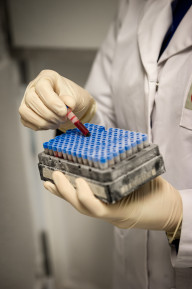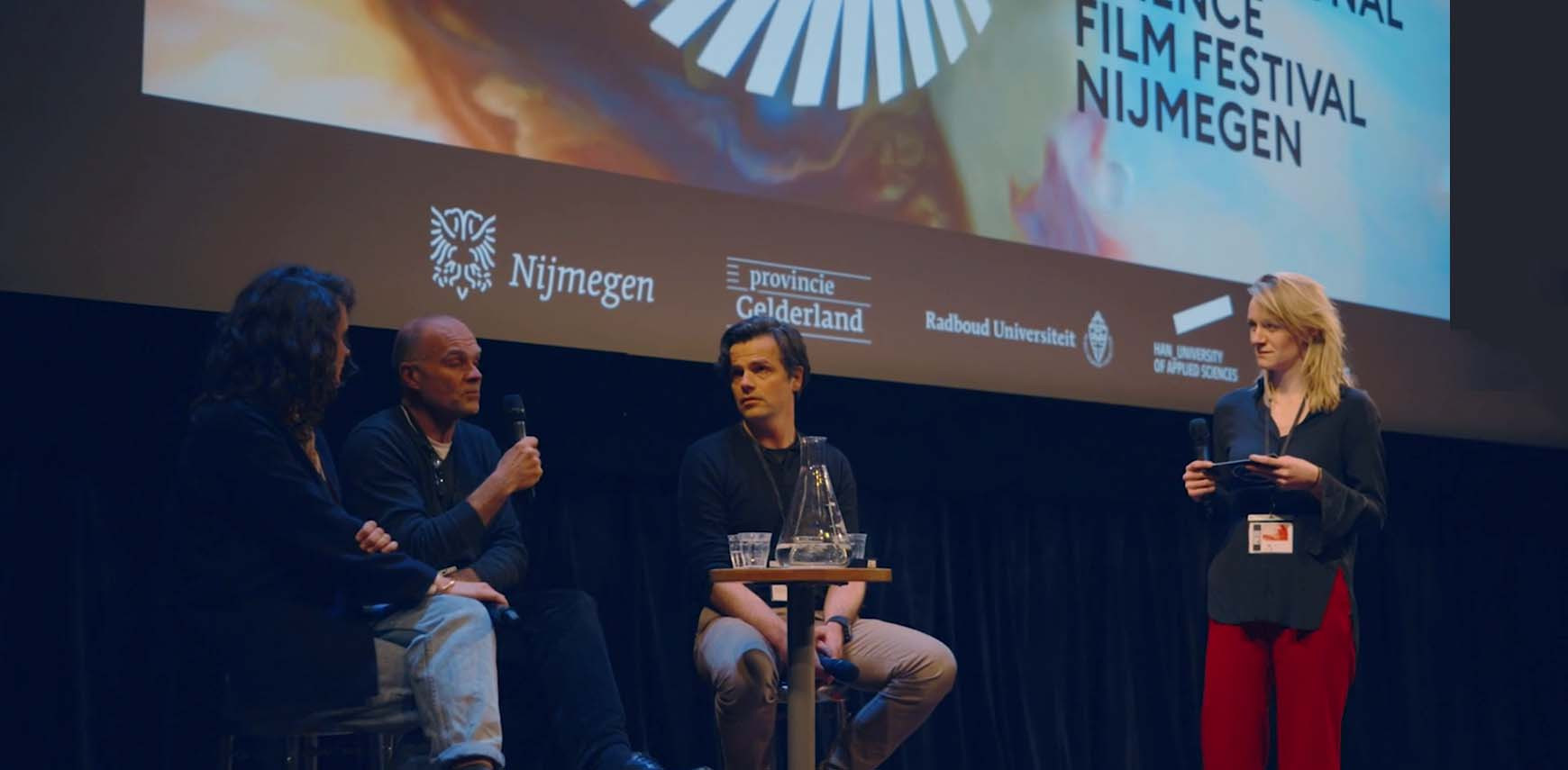From the lab to the blue carpet: Biobank fascinates film festival audience
It is, of course, something completely different. Our scientists often venture beyond their familiar laboratories and typical zoo environments, but they seldom put themselves in the spotlights at an international film festival. In the Dutch city of Nijmegen on 18 March 2023, two of our very own experts enthusiastically joined the panel following the viewing of a documentary on the American San Diego Zoo’s Frozen Zoo. Manager of the Antwerp ZOO Centre for Research & Conservation (CRC) Zjef Pereboom answered questions from the floor, assisted by Biobank Research Coordinator Philippe Helsen. Their perspective is exceptionally interesting, because the documentary reveals that we can clone animals and bring extinct species back to life from genetic material stored in test tubes. We can do this, but must we, may we, should we and do we actually do this in Europe too?
Rather than sensational action scenes and world-famous TV stars, the big screens at Nijmegen’s Cinema Lux feature stem cells, super freezers and microscopes. Director Susanne Linsen was commissioned by Dutch public service broadcaster NTR to create the documentary De Kennis van Nu: de diepvriesdierentuin (translation: ‘Science Today: the Frozen Zoo’, ed.) and is eager to tell us more about it. ‘This video is about the Frozen Zoo, an institute at the San Diego Zoo where they try to save animal species by using deep-frozen genetic material. Some of their samples were frozen many years ago. Time stands still for this material.’
‘Biobanks allow us to clone animals, but should we, may we, must we and do we actually do this?’
According to Linsen, a film does not need a spectacular plot or Oscar-winning actors to keep an audience enthralled. ‘Watching scientists take all those test tubes from the freezer with the utmost care is incredibly intriguing. Seeing those minuscule test tubes, it is almost incomprehensible to me that they contain an immense number of animal species. And that skin cells can become stem cells and, after that, even embryos, thanks to their efforts. I want, above all, to show these scientists’ drive and passion, and observe their process from close up. Will they truly succeed in cloning animals or bringing extinct species back to life? How do they respond to this? Will there be tears or euphoria? I want my documentary to put the enthusiasm and perseverance of these scientists in the spotlights.’
The added value of experts
Scientists even play a leading role at the science film festival. According to film programmer Rob van den Bergh: ‘The intention behind the InScience International Science Film Festival is to make science more easily accessible to the general public through film and art.’ Imagine this: a blue carpet, première showings of films, silent disco after-parties, camera teams interviewing directors ... and scientists putting their expertise at the disposal of the audience to explain what they have just seen. ‘We believe that in-depth panel discussions like this are a crucial element in this festival. We don’t need to emulate the festivals of Cannes or Venice; we aim to distinguish ourselves by offering scientific explanations and interactive activities after our showings.’
The organisers knew instantly that they wanted to invite Antwerp ZOO for a panel after showing the film about the frozen zoo. ‘Antwerp ZOO is the initiator of the European Biobank, the European equivalent of what is shown in the film. It was obvious that the added value contributed by experts like Philippe Helsen and Zjef Pereboom would help the audience better process what they had just seen.’
Kurt & the white rhinoceroses
Linsen used two specific examples to illustrate the way in which the American Biobank operates. One of these concerns a Przewalski horse. Kurt was an exact clone of an animal from the 1980s. Scientists created an embryo from a sample in the American Biobank and implanted this in a mare. Several months later, Kurt was trotting alongside his surrogate mother, safely hidden from visitors. The idea was that Kurt – with his unique genetic material – would help to genetically diversify the Przewalski population in the wild and, by doing so, save this species from extinction.
‘Creating an embryo of an extinct northern white rhinoceros or bringing the clone of a Przewalski horse into the world: this may be futurist and “Frankensteinesque”, but they really do this at the San Diego Zoo.’
Another example chosen by Linsen shows how scientists are using the same technology to bring the nearly extinct northern white rhinoceros back to life. All that is left of this species is two living females ... and genetic material taken from the last deceased males. The film shows the southern white rhinoceros females being trained as surrogate mothers at the San Diego Zoo with the goal of having them carry embryos of the northern species supplied by the American Biobank and subsequently releasing an extinct species back into the wild.
Can, must, may, should?
After showing the film, the audience responded with words such as ‘interesting, futurist and ‘Frankensteinesque’. The consensus is that it is amazing that this can be achieved thanks to a Biobank. But should we want to do this, and ought we?

‘We don’t do this in Europe or at Antwerp ZOO,’ explains Helsen, whose work in the ZOO’s genetics laboratory involves thousands of serum, blood and DNA samples retained by the European Biobank. ‘Recreating a northern white rhinoceros in a laboratory is an unfathomably immense project, while there might very well be a better alternative. There are still southern white rhinoceros that can play the same ecological role in the wild as northern ones.’ Pereboom also harbours uncertainties: ‘Wouldn’t it be better to put our energy and resources into improving this species’ chances of survival, without having to opt for artificial and ethically controversial methods? We must dare to open up the ethical discussion – also in Europe.’ Or: ‘Scientists can keep going, but we want our work to be relevant to society. The film festival and the questions from the general public serve as a window to reality.’
Kurt’s story better reflects the current approach adopted in Europe. ‘The American approach shown in the documentary focused on a single animal, in which a great deal of time, energy and money was invested. They had good reasons for doing this, because Kurt is the clone of a stallion never used for breeding in a zoo. His sample was therefore genetically unique in comparison to all Przewalski horses alive today. He really contributes added value to the population. This is crucial information for the relevance of this approach. In Europe, we would never consider creating a clone such as Kurt. Our Biobank focuses on the genetic analysis of many more animals. But similar to the Kurt, we base our research on samples of ‘primordial animals’ from the European zoo. Their genetic material is extremely pure and, based on this, we can perfectly see which animals have generated a lot of offspring and which ones are a bit more unique. We hope that breeding programmes based on the latter group will keep animal populations both healthy and diverse, before resorting to cloning a “primordial’ animal” like Kurt.’
The two scientists from Antwerp ZOO fully agree that, whichever way you look at it, collecting samples is an excellent idea. ‘This reflects the EAZA’s approach with regard to the Biobank. The San Diego Zoo focuses more strongly on making use of the material and manipulating it, to create embryos, for example,’ explains Pereboom. Helsen agrees with him wholeheartedly. ‘You must retain samples; this is indisputable. You could see this as species conservation in a freezer. Even if the effective use of these samples is a highly complex issue, as is clearly shown in the documentary. The unique material in our Biobank has nevertheless served as an accelerator for scientific research on endangered species, It may sound less exotic and heroic, but the quest for a few crucially important samples will no longer require months of field work, but can take place at the computer. Not retaining these samples would not make this possible and the DNA of these animals or species would be lost forever. This is something the audience must understand. The Biobank plays an indispensable role in the conservation of animal species.’
Would you like to learn more about our European Biobank? Be sure to read: BIOBANK ALS BACK-UP

